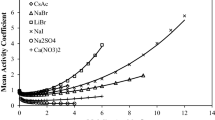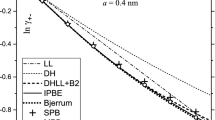Abstract
The Laliberte–Cooper thermodynamic model has been previously successfully applied to calculate the density of aqueous solutions of electrolytes. The model allows prediction of the density of a multielectrolyte solution on the basis of known volume properties of binary solutions. The paper presents a new principle for selecting compositions of binary solutions in the Laliberte–Cooper model, which is based on the equality of the ionic strength of the multielectrolyte and binary solutions. We compare results of density calculations, both when the ionic strength is factored in and when it is not. In the case of strong electrolytes, when the ionic strength is taken into account, the accuracy of predicting the multielectrolyte solution density improves.
Graphical Abstract





Similar content being viewed by others
References
Krumgalz, B.S., Pogorelsky, R., Pitzer, K.S.: Ion interaction approach to calculations of volumetric properties of aqueous multiple-solute electrolyte solutions. J. Solution Chem. 24, 1025–1038 (1995)
Lalibertґe, M., Cooper, W.E.: Model for calculating the density of aqueous electrolyte solutions. J. Chem. Eng. Data 49, 1141–1151 (2004)
Laliberte, M.: A model for calculating the heat capacity of aqueous solutions, with updated density and viscosity data. J. Chem. Eng. Data 54, 1725–1760 (2009)
Reynolds, J.G., Carter, R.: The Laliberté–Cooper density model: self-consistency and a new method of parameterization. Fluid Phase Equilib. 266, 14–20 (2008)
Agnew, S.F.: Rescaled specific volume model for electrolyte solution density. J. Chem. Eng. Data 57, 60–65 (2012)
Young, T.F., Smith, M.B.: Thermodynamic properties of mixtures of electrolytes in aqueous solutions. J. Phys. Chem. 68, 716–724 (1954)
Krumgalz, B.S., Millero, F.J.: Physico-chemical study of dead sea waters II. Density measurements and equation of state of Dead Sea waters at 1 atm. Mar. Chem. 11, 477–492 (1982)
Saluja, P.P.S., Jobe, D.J., LeBlanc, J.C., Lemire, R.J.: Apparent molar heat capacities and volumes of mixed electrolytes: [NaCl(aq) + CaCl2(aq)], [NaCl(aq) + MgCl2(aq)], and [CaCl2(aq) + MgCl2(aq)]. J. Chem. Eng. Data 40, 398–406 (1995)
Fedyainov, N.V.: Specific heat of two- and three-component aqueous solutions of beryllium subgroup metal chlorides at 25 °C. Russ. J. Phys. Chem. 44, 1817–1819 (1970)
Li, J., Prestidge, C.A., Addai-Mensah, J.: Viscosity, density, and refractive index of aqueous sodium and potassium aluminate solutions. J. Chem. Eng. Data 45, 665–671 (2000)
Sipos, P., Stanley, A., Bevis, S., Hefter, G., May, P.M.: Viscosities and densities of concentrated aqueous NaOH/NaAl(OH)4 mixtures at 25 °C. J. Chem. Eng. Data 46, 657–661 (2001)
Königsberger, E., Bevis, S., Hefter, G., May, P.M.: Comprehensive model of synthetic Bayer liquors. Part 2. Densities of alkaline aluminate solutions to 90 °C. J. Chem. Eng. Data 50, 1270–1276 (2005)
Pomeroy, R., Kirschman, H.D.: The solubility of sodium iodide in sodium hydroxide solutions at 20°. J. Am. Chem. Soc. 66, 178–179 (1944)
Kirschman, H.D., Pomeroy, R.: The solubility of potassium iodide in sodium hydroxide solutions at 20°. J. Am. Chem. Soc. 66, 1793–1794 (1944)
Salavera, D., Libotean, S., Patil, K.R., Esteve, X., Coronas, A.: Densities and heat capacities of the ammonia + water + NaOH and ammonia + water + KOH solutions. J. Chem. Eng. Data 51, 1020–1025 (2006)
Acknowledgements
This study was supported by the government program № CITIS 121031300039-1 “Chemical thermodynamics and theoretical materials science”.
Author information
Authors and Affiliations
Contributions
Mamontov M.N.: Conceptualization, Investigation, Data Curation, Writing—Original Draft. Gorbachev A.V: Data Curation, Writing—Review & Editing.
Corresponding author
Ethics declarations
Conflict of interest
The authors declare that they have no known competing financial interests or personal relationships that could have appeared to influence the work reported in this paper.
Additional information
Publisher's Note
Springer Nature remains neutral with regard to jurisdictional claims in published maps and institutional affiliations.
Rights and permissions
About this article
Cite this article
Mamontov, M.N., Gorbachev, A.V. Accounting for Ionic Strength in the Laliberte–Cooper Density Model for Electrolyte Solutions. J Solution Chem 51, 357–369 (2022). https://doi.org/10.1007/s10953-021-01138-8
Received:
Accepted:
Published:
Issue Date:
DOI: https://doi.org/10.1007/s10953-021-01138-8




